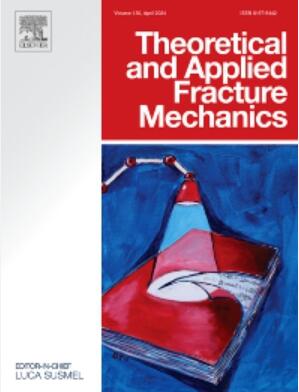Numerical study of the effect of residual stresses on fracture toughness in the microstructure of ZrO2 ceramics
IF 5
2区 工程技术
Q1 ENGINEERING, MECHANICAL
引用次数: 0
Abstract
This study investigates the influence of residual stresses on crack propagation in the microstructure of zirconium ceramics using the element elimination technique (EET) within the finite element method (FEM) framework. The effect of grain size distribution, morphology, and phase distribution are examined. The crack resistance is evaluated for two representative microstructures of zirconia ceramics, considering the role of residual stresses in the constitutive phases. The analysis is conducted under both uniaxial tension and three-point bending conditions.
Results indicate that under tensile loading, residual stresses reduce the maximum sustainable load and, consequently, decrease crack resistance by approximately 30%. In contrast, under three-point bending, residual stresses enhance the crack resistance. The computational modeling results are validated through experimental testing of sintered ceramic samples with a similar grain structure in 3-point bending. The strong agreement between numerical and experimental results confirms the accuracy of the proposed model and highlights the significant role of residual stresses in determining the mechanical properties of zirconia ceramics.
残余应力对ZrO2陶瓷显微组织断裂韧性影响的数值研究
本文采用有限元法(FEM)框架,利用单元消元技术(EET)研究了残余应力对锆陶瓷微观结构裂纹扩展的影响。考察了晶粒尺寸分布、形貌和相分布的影响。考虑残余应力在氧化锆陶瓷本构相中的作用,对两种具有代表性的氧化锆陶瓷微观结构的抗裂性能进行了评价。分析是在单轴拉伸和三点弯曲条件下进行的。结果表明,在拉伸载荷下,残余应力降低了最大持续载荷,从而使抗裂性能降低了约30%。而在三点弯曲下,残余应力增强了材料的抗裂能力。通过对具有相似晶粒结构的烧结陶瓷试样进行三点弯曲试验,验证了计算模型的正确性。数值结果与实验结果吻合较好,证实了模型的准确性,强调了残余应力在氧化锆陶瓷力学性能中的重要作用。
本文章由计算机程序翻译,如有差异,请以英文原文为准。
求助全文
约1分钟内获得全文
求助全文
来源期刊

Theoretical and Applied Fracture Mechanics
工程技术-工程:机械
CiteScore
8.40
自引率
18.90%
发文量
435
审稿时长
37 days
期刊介绍:
Theoretical and Applied Fracture Mechanics'' aims & scopes have been re-designed to cover both the theoretical, applied, and numerical aspects associated with those cracking related phenomena taking place, at a micro-, meso-, and macroscopic level, in materials/components/structures of any kind.
The journal aims to cover the cracking/mechanical behaviour of materials/components/structures in those situations involving both time-independent and time-dependent system of external forces/moments (such as, for instance, quasi-static, impulsive, impact, blasting, creep, contact, and fatigue loading). Since, under the above circumstances, the mechanical behaviour of cracked materials/components/structures is also affected by the environmental conditions, the journal would consider also those theoretical/experimental research works investigating the effect of external variables such as, for instance, the effect of corrosive environments as well as of high/low-temperature.
 求助内容:
求助内容: 应助结果提醒方式:
应助结果提醒方式:


